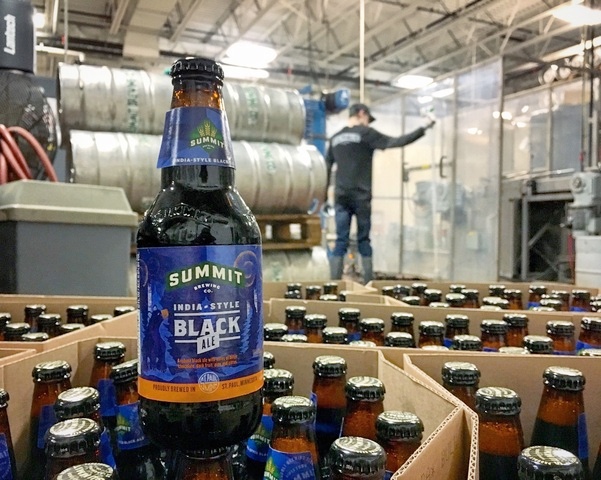Head Brewer Damian McConn: ‘It Can’t Be Black and Pale at the Same Time. That Doesn’t Make Any Sense.’

Summit’s brand-new India-Style Black Ale has just gone into kegs and bottles, and now it’s about to land in select bottle shops as part of the IPA Collection — packaged alongside Summit Sàga, True Brit and Horizon Red IPA.
Between meetings and amid the excitement of the beer’s release, Head Brewer Damian McConn agreed to sit down in his office and talk about the new beer. A co-worker walks in sipping a freshly poured glass of Black Ale.
“Where’d you find that?” Damo asks, nodding at the new beer. “Do you have one for me?” His co-worker shakes his head and Damo laughs. He settles instead for a close look at the beer in its tulip glass.
“People drink with their eyes,” he says. “First they see the foam, then they see the color.” Pouring with a big frothy tan head, a boot polish black body, and a slight red tinge at the bottom of the glass, the Black Ale certainly looks tasty.
As for flavor, Damo says, it’s got roasted Patagonia Perla Negra for notes of espresso, as well as roasted Midnight Wheat — which hasn’t been used in any other Summit brews — for some bitter chocolate. Layered on top of that malt foundation, pineapple flavor comes from Denali, a brand-new West Coast hop that Summit is using for the first time. Tangerine, orange, black pepper, pine and mint also make appearances, but that overarching combination of chocolate and citrus dominates, reminding Damo of a particular candy — Terry’s Chocolate Orange ball, made since 1932 in York, England.
“The Black Ale’s got a big hop wallop when you first drink it,” Damo says, “and then as you get through the beer it backs off quite a bit. That kind of makes you want to drink a bit more.”
Damo and the rest of brewing team first started kicking around ideas for the Black Ale back in May 2016, identifying the style’s dark color and roasted flavors as the best way to round out the IPA Collection.
“Now we have four very distinct beers [in the box]. They’re distinct from one another and distinct from other beers on the market,” Damo says. “You want this beer to be black, but you don’t want there to be so much roasted material that it dominates the flavor profile. You want to get your color right, but you don’t want it to be a porter or a stout.” Damo went through five different iterations of the recipe before he and the other brewers got the Black Ale right where they wanted it.
With an ABV around 6.8% and 70 IBUs, Damo says the hop presence is powerful, as it should be in a traditional IPA, “but there’s enough malt in there to provide a nice foundation. It’s got a nice integration of those malt flavors with the American and German hops on top of it. Plus, the Yorkshire yeast strain, which we had never used before, gives it a slightly apple or pear note. I think it turned out well. I’m really happy with it.”
Like he always does when he’s working on a new brew, Damo looked to historical European styles for guidance and inspiration. He wanted something that had a solid link to a historical beer style, he says, “as opposed to some made-up piece of crap.”
“The Brits would make these really heavily hopped brown ales and porters in the 19th century for export, so there are actually some really nice recipes for this type of beer with a little more roast character and high hopping rate. And they didn’t call them Black IPAs, which doesn’t make any sense — it can’t be black and pale at the same time! The Victorian brewers called them Export Black Ales or India Black Ales, depending on the brewery.”
If you go back to the roots of any style, even if it’s a subset of a substyle, Damo says, “You can come to understand where those brewers were coming from while creating that beer, and then you can take that basic concept and put your own creative spin on it.” By ensuring that the Black Ale had its foundation in traditional brewing, Damo was then able to bring in more modern ingredients, such as new hop varieties — so long as the beer met his standards. “I’m always looking for drinkability, clean bitterness, and integration,” he says.
Integration of the final beer comes from carefully combining all of the elements — the roasted malts, the various hops, the chemistry of the water used in the beer — and balancing them so no single flavor or characteristic dominates the others.
“Water,” Damo says, “is the most boring recipe ingredient that nobody thinks about, and it’s not very romantic to talk about water chemistry, but everybody needs to think about water! The boys did a great job managing all of that in the brew house. It was a team effort all the way.”
Summit India-Style Black Ale is very limited on draught and packaged only inside the IPA Collection. Find yours here.


Leave a Reply